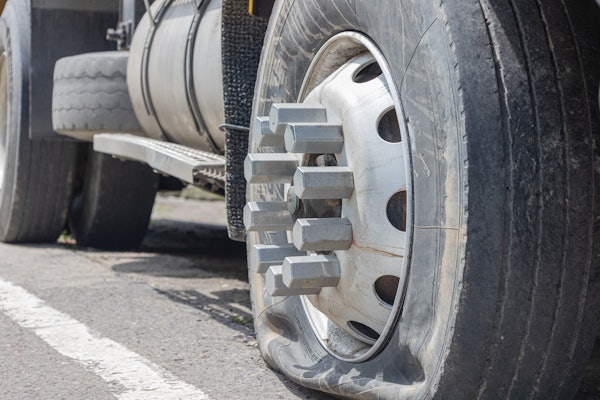The American Transportation Research Institute in 2019 published research on marijuana legalization and impaired driving, and how it impacts highway safety. Now, four years later, ATRI has released new research about how marijuana legalization at the state level is impacting the trucking industry.
Joining Matt and Jason this week is ATRI Vice President Jeffrey Short, who talks about the study and its findings, including how legalization has impacted highway safety, the number of drivers disqualified because of marijuana since FMCSA’s Drug and Alcohol Clearinghouse took effect in 2020, and carriers’ and drivers’ perceptions of possible future changes to federal marijuana laws and more.
Contents of this video
00:00 Legalized recreation marijuana and the trucking workforce
03:13 Driving while impaired by marijuana
04:58 Marijuana impairment field test
07:48 Drug and alcohol clearinghouse
10:00 Hiring drivers with past positive marijuana test
11:26 Are changes in federal drug testing policy needed?
12:37 Removing marijuana from Schedule I
Jason Cannon:
This week's 10-44 is brought to you by Chevron Delo 600 ADF ultra low ash diesel engine oil. It's time to kick some ash.
Matt Cole:
Recreational marijuana is now legal in 23 states, but it's still illegal at the federal level for truck drivers. How is that impacting the industry?
Jason Cannon:
You're watching CCJ's 10-44, a weekly webisode that brings you the latest trucking industry news and updates from the editors of CCJ. Don't forget to subscribe and hit the bell for notifications, so you'll never miss an installment of 10-44.
Hey everybody, welcome back. I'm Jason Cannon and my co-host on the other side is Matt Cole. The American Transportation Research Institute in 2019 published research on marijuana legalization and impaired driving and how it impacts highway safety. Now, four years later, ATRI has released new research about how marijuana legalization at the state level is impacting the trucking industry.
Matt Cole:
ATRI's new report aims to quantify the impact of the legalization of marijuana on the trucking workforce. Joining us this week is ATRI Vice President Jeffrey Short, who talks about the study and its findings, including how legalization has impacted highway safety, the number of drivers disqualified because of marijuana since FMCSA's Drug and Alcohol Clearinghouse took effect in 2020, and carriers and drivers' perceptions of possible future changes to federal marijuana laws and more.
Jeffrey Short:
The 2019 research, we were focused on what was going on as far as safety, what were the safety consequences and what was being done to make sure there were not impaired drivers on the roadway? What we found in 2019 is there wasn't a whole lot going on. There's no impairment test that police can use. So, they were relying on a small number of subject matter experts essentially who could identify, based on an interview, more qualitatively than quantitatively whether someone was impaired or not. It was not a breathalyzer test or a blood test, et cetera.
Moving towards the 2023 report, we wanted to look at what the impact of this is on the overall workforce because at the end of the day, in 2019, we had 10 states that had legal recreational marijuana. We now have 23, and that puts a lot more people living in locations where they can legally get marijuana. There's a whole lot of confusion, as we'll discuss, about whether or not a driver can use marijuana in a state where it's legal. Of course, they cannot do that. So, we wanted to see what the impact of this was on carriers and drivers from a workplace standpoint, from a workforce standpoint as well. What are the impacts on the workforce at the end of the day, and what are we going to have to do going forward to make sure that there are enough drivers who can legally drive under federal regulations?
Jason Cannon:
Now, it's no secret at all that driving while impaired by marijuana is dangerous, but because there is currently no test to determine impairment, it's hard to measure how much of an impact marijuana legalization has had on highway safety. Now, Jeffrey says, research suggests that there has been a negative impact.
Jeffrey Short:
It certainly has an impact on driving and your ability to drive. At the end of the day, driving and using marijuana at the same time? Definitely not a good thing. We went through research studies over the years looking at intoxicated drivers, and it definitely negatively impacts driving performance. It's not fully understood. One of the bigger questions out there is there are different levels of potency and people don't react to marijuana the same way they do alcohol. Alcohol is you know what you're getting when you drink it and you know what it's going to do to you for the most part. There's not a lot of variation, but with different strains of marijuana and potencies, that's all out the window.
As far as overall highway safety, the initial data does suggest that marijuana legalization has negatively impacted highway safety, particularly in non-fatal crashes. Of course, more research is needed. Marijuana needs to be legal for a longer period of time for us to really understand that and very important to this, again, is understanding how much driving is being done while impaired and how many accidents are attributable to marijuana and how attributable those accidents are to marijuana use. Without a decent impairment test, which is a difficult thing to get to, this is not going to be easy. I have seen research where somebody would be able to scan the brain somehow and see that there's marijuana activity or marijuana-related activity in the brain, and that could be a good way to do it.
Of course, that kind of equipment sounds very expensive. It doesn't sound like something easily deployed by an officer in the field. It certainly looks like there are some challenges there. There are folks out there who've been working on this forever who say, "There just isn't going to be a breathalyzer test. There isn't going to be an agreed upon drug test, at least not anytime soon for impairment." Right now, there's no other way to describe the current marijuana testing protocol for truck drivers. It's a use test. It's a test of past use. It really doesn't tell you whether or not someone is currently using marijuana. It just says that they have used marijuana in the past, let's say, two, three up to four weeks perhaps. It is the most critical piece of the puzzle here, but again, not one that's easy to get to. Hopefully, there's going to be a lot more research and research dollars going out there to the scientific community to do this sort of thing.
Matt Cole:
According to FMCSA's latest Drug and Alcohol Clearinghouse monthly update, of the 200,000 plus positive drug tests reported to the database, 114,000 of those are due to marijuana. After a word from 10-44 sponsor Chevron Lubricants, we'll hear more from Jeffrey about those numbers and what they mean for trucking.
Ad:
Protecting your diesel engine and its after-treatment system has traditionally been a double-edged sword. The same engine oil that is so essential to protecting your engine's internal parts is also responsible for 90% of the ash that is clogging up your DPF and upping your fuel and maintenance costs. Outdated industry thinking still sees a trade-off between engine and emission system protection, and Chevron was tired of it. So, they spent a decade of R&D developing a no compromised formulation.
Chevron lubricants developed a new ultra low ash diesel engine oil that is specifically designed to combat DPF ash clogging. Delo 600 ADF with omnimax technology cuts sulfate ash by whopping 60%, which reduces the rate of DPF clogging and extends DPF service life by two and a half times. Just think what you can do with all the MPGs you're going to add from cutting your number of regens. But Delo 600 ADF isn't just about after-treatment. It provides complete protection, extending drain intervals by preventing oil breakdown. Before, you had to choose between protecting your engine or your after-treatment system. Now, you don't. 600 ADF from Delo with omnimax technology, it's time to kick some ash.
Jeffrey Short:
A very small number, a very small percentage of folks who get a positive test and wind up in prohibited status and in the Drug Clearinghouse, very small number go through the return to duty process. If I look at January, looking at some January 2023 data and the numbers you cited are more recent at the 200,000 level, but let's say, back then it was 166,000, only 45,000 of those, that's over a three-year period, had made it into not-prohibited status. Those with their follow-up testing plan complete, everything's done, they're back in the workforce, that's only 7,000. That's just a couple percent of those who have been identified by the Drug and Alcohol Clearinghouse, who have been referred to the Drug and Alcohol Clearinghouse.
What this says is a lot of folks are just not returning to a federally regulated driving position. They're going elsewhere. When you look at the numbers, 57% of those drug tests, 57% of those being caught, it's for marijuana. It's not for the other drugs that are out there that are far more dangerous, based on many people's opinion. Cocaine, methamphetamine, opioids, those sorts of drugs. When you look at something like cocaine, really it is only staying in your system and could be detected by the current protocol for a day or two, maybe up to three or four days. It's not like marijuana, which has this huge window of deductibility. If we're talking hair testing, of course, hair testing can go out 90 days, but hair testing is not currently recognized. So, it's not a way you would be referred to the Drug and Alcohol Clearinghouse.
Jason Cannon:
As part of the research, ATRI surveyed both carriers and drivers about marijuana laws and their impact on the industry. In the carrier survey, ATRI found that carriers are willing to rehire a driver with a previous positive drug test for marijuana with some caveats.
Jeffrey Short:
Some of the caveats, of course, were between marijuana and other drugs. Some of the open-end answers who they would and who they would not rehire. Marijuana, certainly carriers are more open to hiring someone with a past marijuana test than cocaine or methamphetamine. Over and over, carriers were saying, "We will not even look at someone with a past cocaine positive or methamphetamine positive test."
But marijuana, folks are more open to, and I have to think that this is something that's evolving as more folks in the United States become more comfortable, I guess, with marijuana, not necessarily embracing it, but they're more comfortable that it's out there and someone might use it and it's not necessarily being used in a dangerous way as long as you're not operating a vehicle. You cannot use marijuana and then operate any kind of vehicle or heavy machinery. It's just not safe.
Matt Cole:
Current drug testing methods, as Jeffrey mentioned before, can detect marijuana use as many as 30 days after the fact, which can include drivers who use recreationally on off-time, but never while working. ATRI's survey found that most carriers and drivers believe there should be changes to federal drug testing policies.
Jeffrey Short:
We asked them, "In light of growing state level legalization of marijuana, do you think changes in testing policies are needed for CDL holders?" 62% said yes. Then we asked, "Would an impairment test instead of the current use test?" 65% said yes. 65% want that. These numbers are very similar to what we were seeing with drivers. They're almost spot on. Drivers were asked the same questions and drivers replied pretty much the same way. It's a growing level of frustration among all parties involved that there are cases here where people are being flagged and removed from the industry and they're not a danger. They don't represent a danger because they're not using while they're working.
Jason Cannon:
Marijuana is currently categorized as a Schedule I drug by the federal government along with heroin, LSD, ecstasy, and a lot of others. Now, if that were to change, Jeffrey says it could be tricky for the trucking industry and other safety sensitive positions.
Jeffrey Short:
There are certainly two things that could happen. The first is status quo continues. Marijuana remains a Schedule I drug, meaning, there is no medical use recognized by the federal government for marijuana. The other is to start to change the schedule, recognize medicinal uses. That gets into some very tricky territory when it comes to safety sensitive positions. We're not just talking trucking industry. We're talking airline pilots, we're talking anyone operating something the size of a truck on public highways, mass transit, rail, maritime. They are all covered to some degree under these rules.
First and foremost, our findings indicate that there are three key things that need to happen before the federal government makes any push towards removing marijuana from Schedule I. The first would be, and we went over this and how difficult it is, but developing nationally recognized marijuana impairment test and impairment standards. What does it mean to be impaired? No one agrees on that right now. We need standards, whether or not that's the amount of marijuana in the bloodstream, and we need tools to measure those standards, so that you can say, "This driver is safe," "This driver is unsafe."
That goes well beyond the trucking industry. This would be something very important for law enforcement to have when dealing with automobile drivers who are under the influence. I know there are automobile drivers under the influence. I drive around the city of Atlanta where I live, and I smell it all the time from a car in front of me with one person in it. So, it's like, "All right, come on." The next piece would be carriers may choose to continue to screen for marijuana or they may want to, and that needs to be protected.
There are laws out there at the state level, and this excludes currently interstate truck drivers, saying you can't discriminate, California's one location, against an employee who uses marijuana recreationally, not on the job. That means no drug testing. That means you can't make a hiring decision based on a marijuana drug test. For safety sensitive employees, that seems like a dangerous approach. So, protecting a motor carrier's choice to screen for marijuana I think is critical. If a carrier wants to do that to protect and they feel this is how they can best protect their drivers and the roadway and road users, then that needs to be protected.
Finally, our last recommendation, or really, requirement, if the federal government were to move forward with Schedule I removal would be collecting better statistics, making those statistics available to the public, so that they can be analyzed, so that research can be conducted. These look not only at marijuana use, it's prevalence, but also safety outcomes. That's really important to understand the safety outcomes of what's taking place here, so that we can understand when you make a change, there's going to be some sort of impact on the public, in this case, public safety. What is that impact? How can we mitigate the dangers that this creates? Data, knowledge, very key to this.
Jason Cannon:
That's it for this week's 10-44. You can read more on ccjdigital.com. While you're there, sign up for our newsletter and stay up to date on the latest in trucking industry news and trends. If you have any questions or feedback, please let us know in the comments below. Don't forget to subscribe and hit the bell for notifications, so you can catch us again next week.










